
Timothy is an abundant perennial grass native to most of Europe except for the Mediterranean region. It is also known as timothy-grass, meadow cat's-tail or common cat's tail. It is a member of the genus Phleum, consisting of about 15 species of annual and perennial grasses.

The parsnip is a root vegetable closely related to carrot and parsley, all belonging to the flowering plant family Apiaceae. It is a biennial plant usually grown as an annual. Its long taproot has cream-colored skin and flesh, and, left in the ground to mature, it becomes sweeter in flavor after winter frosts. In its first growing season, the plant has a rosette of pinnate, mid-green leaves. If unharvested, in its second growing season it produces a flowering stem topped by an umbel of small yellow flowers, later producing pale brown, flat, winged seeds. By this time, the stem has become woody and the tap root inedible.

Heracleum maximum, commonly known as cow parsnip, is the only member of the genus Heracleum native to North America. It is also known as American cow-parsnip, Indian celery, Indian rhubarb or pushki. It is sometimes referred to as Heracleum lanatum, which is regarded as a synonym. The genus name Heracleum refers to the very large size of all parts of these plants.

Leucanthemum vulgare, commonly known as the ox-eye daisy, oxeye daisy, dog daisy, marguerite and other common names, is a widespread flowering plant native to Europe and the temperate regions of Asia, and an introduced plant to North America, Australia and New Zealand.
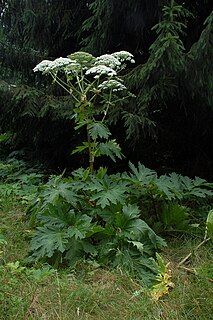
Heracleum mantegazzianum, commonly known as giant hogweed, is a monocarpic perennial herbaceous flowering plant in the carrot family Apiaceae. H. mantegazzianum is also known as cartwheel-flower, giant cow parsley, giant cow parsnip, or hogsbane. In New Zealand, it is also sometimes called wild parsnip or wild rhubarb.
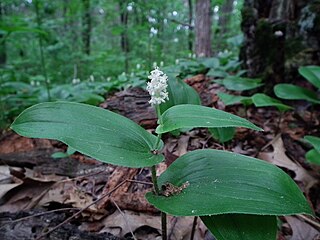
Maianthemum canadense is an understory perennial flowering plant, native to Canada and the north-eastern United States, from Yukon and British Columbia east to Newfoundland, into St. Pierre and Miquelon. It can be found growing in both coniferous and deciduous forests. The plant appears in two forms, either as a single leaf rising from the ground with no fruiting structures or as a flowering/fruiting stem with 2-3 leaves. Flowering shoots have clusters of 12–25 starry-shaped, white flowers held above the leaves.
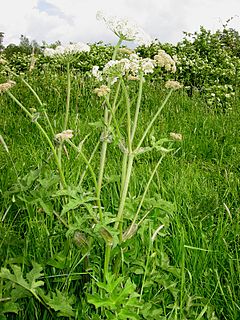
Heracleum sphondylium, commonly known as hogweed, common hogweed or cow parsnip, is a herbaceous perennial or biennial plant, in the umbelliferous family Apiaceae that includes fennel, cow parsley, ground elder and giant hogweed. It is native to Europe and Asia. The common name eltrot may also be applied, but is not specific to this species. Umbelliferous plants are so named because of the umbrella-like arrangement of flowers they produce. The North American species Heracleum maximum is sometimes included as a subspecies of H. sphondylium.
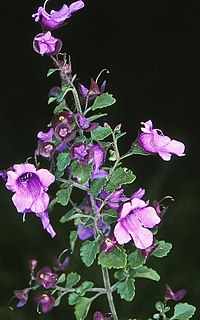
Prostanthera incisa, commonly known as cut-leaf mint-bush, is a species of flowering plant in the family Lamiaceae and is endemic to south-eastern continental Australia. It is an erect, strongly aromatic, openly branched shrub with hairy, densely glandular branches, egg-shaped to oblong leaves, and pale mauve to mauve flowers.

Knautia arvensis, commonly known as field scabious, is a herbaceous perennial species of flowering plant in the honeysuckle family Caprifoliaceae.

Trachymene is a genus of herbaceous plants in the family Araliaceae. The species are native to Australia, Malesia, New Caledonia and Fiji.

Sium suave, the water parsnip or hemlock waterparsnip, is a perennial wildflower in the family Apiaceae. It is native to many areas of both Asia and North America. The common name water parsnip is due to its similarity to parsnip and its wetland habitat. The alternate common name hemlock waterparsnip is due to its similarity to the highly poisonous spotted water hemlock.

Crinum asiaticum, commonly known as poison bulb, giant crinum lily, grand crinum lily, spider lily, is a plant species widely planted in many warmer regions as an ornamental plant. It is a bulb-forming perennial producing an umbel of large, showy flowers that are prized by gardeners. All parts of the plant are, however, poisonous if ingested. Some reports indicate exposure to the sap may cause skin irritation.

Eriogonum flavum is a species of wild buckwheat.

Urtica incisa, commonly called scrub nettle, stinging nettle, and tall nettle, is an upright perennial herb native to streams and rainforest of eastern and southern Australia, from the north–east southwards through the east, of Queensland and New South Wales, then across the south, through Victoria, Tasmania, south-eastern South Australia and parts of southern Western Australia. Also widespread in the North and South Island of New Zealand.

Dianella revoluta, commonly known as blueberry lily, blue flax-lily, or black-anther flax-lily, a species of flowering plant in the family Asphodelaceae and is endemic to, and widespread in Australia. It is a tufted, perennial herb with grass-like leaves and up to nine blue or violet flowers with six tepals, and stamens with bright yellow filaments and pale brown to almost black anthers.

Ligusticum scoticum, known as Scots lovage, or Scottish licorice-root, is a perennial flowering plant in the celery family Apiaceae found near the coasts of northern Europe and north-eastern North America. It grows up to 60 centimetres (24 in) tall and is found in rock crevices and cliff-top grassland. It is closely related to, and possibly conspecific with, Ligusticum hultenii from the coast of the northern Pacific Ocean. The plant is edible and contains the compound sotolon, which is also present in fenugreek. The leaves have a flavour similar to parsley or celery, while the seeds taste similar to fenugreek or cumin.
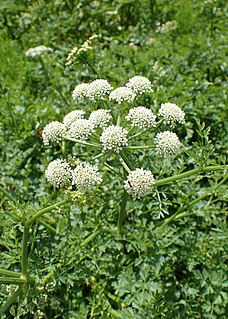
Oenanthe crocata, the hemlock water-dropwort, also known as dead man's fingers, is a flowering plant in the carrot family, Apiaceae, native to the British Isles, Western Europe and the Iberian Peninsula. All parts of the plant are extremely toxic and have been implicated in several cases of livestock poisoning. The toxic leaves and stems look like parsley; the highly toxic roots look and smell like parsnips.

Serruria fasciflora or common pin spiderhead is a species of flowering plant in the family Proteaceae. It is a sprawling to upright shrublet of 40 cm to 1 m high and about 1⁄2 m wide. It has finely divided, upward curving leaves with thread-thin segments and clusters of sweetly scented heads, each consisting of five to seven silvery pink flowers, that may be found year-round, but mostly from May to December. It is a rather widespread and common species, that is restricted to the south of the Western Cape province of South Africa.

Hypericum majus, the greater Canadian St. John's wort, is a perennial herb native to North America. The specific epithet majus means "larger". The plant has a diploid number of 16.
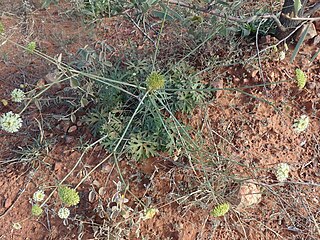
Trachymene ochracea is a herb in the family Araliaceae. It is native to Australia and found in New South Wales and Queensland.



















